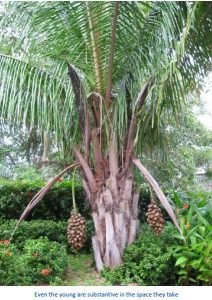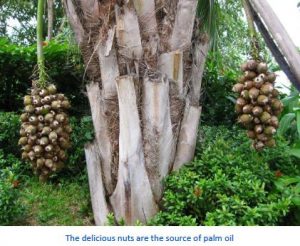By Tommy Clarkson from the March 2017 Edition
American Oil Palm, Elaeis oleifera
Family: Arecaseae
(At the sake of presumption, I respectfully state that I take exception with some of my secondary research  sources! Some of these speak of the Elaeis oleifera as synonymous with the Corzo oleifera, describing it as a “solitary creeping trunk” palm with a trunk of only 6 ½ to 13 feet (2-4 meters). Such IS NOT the oil palm I see around these environs and from which I have collected and eaten its mature nuts which taste a great deal like Brazil Nuts.
sources! Some of these speak of the Elaeis oleifera as synonymous with the Corzo oleifera, describing it as a “solitary creeping trunk” palm with a trunk of only 6 ½ to 13 feet (2-4 meters). Such IS NOT the oil palm I see around these environs and from which I have collected and eaten its mature nuts which taste a great deal like Brazil Nuts.
The palm with which I am quite familiar, clearly, is close kin to the Elaeis guineensis, from “the Dark Continent”. I am highly suspect that this is another of those cases, occasionally en-countered in tropical botany, wherein not enough time, attention and “hands on” study has been given in order to ensure full and correct identification.
Hence, much of that which follows is from my personal study and observation of what I believe to be the correctly identified and thriving in substantive proliferation around the Mexican States of southern Jalisco and North Colima American Oil Palm.)
 According to the International Palm Society’s tome, “Genera Palmarum (The Evolution and Classification of Palms)” the two species of the genus Elaeis palms are “solitary, pinnate leaved palms from South and Central America and humid tropical Africa.” David L. Jones, in his book “Palms throughout The World” describes them further as “stout, armed (meaning to bear spines or prickles), solitary, feather-leaved palms which lack a crownshaft.”
According to the International Palm Society’s tome, “Genera Palmarum (The Evolution and Classification of Palms)” the two species of the genus Elaeis palms are “solitary, pinnate leaved palms from South and Central America and humid tropical Africa.” David L. Jones, in his book “Palms throughout The World” describes them further as “stout, armed (meaning to bear spines or prickles), solitary, feather-leaved palms which lack a crownshaft.”
So – based on having specimens of each in Ola Brisa Gardens what, then, are the differences between the African Oil Palm (Elaeis guineensis) and the American Oil Palm?
While both have thick trunks and sport long fronds, they have an easily-identifiable visual difference. When asked to describe the American Oil Palm, I often say, “Imagine a big brother to a Coconut Palm with gelled, spiky hair sticking upwards like that which was popular among the “punk” set for a while!” That is to say that a mature, healthy African Oil Palm, with its large, drooping fronds, would look more like a Coconut Palm than would its cousin from the tropical Americas.
The African Oil Palm (Elaeis guineensis) which of the two is, perhaps, more important commercially is  now the cultivated source of oil in West and Central Africa. The American Oil Palm, (Elaeis oleifera), originating in Central and South America, also a source of Palm Oil, is sometimes grown under the erroneous names of Elaeis melanococca.
now the cultivated source of oil in West and Central Africa. The American Oil Palm, (Elaeis oleifera), originating in Central and South America, also a source of Palm Oil, is sometimes grown under the erroneous names of Elaeis melanococca.
Appropriately enough, the American Oil Palm’s Latin name stems from the Greek word for “oil-bearing” or “olive tree” which alludes to the oil extracted from it.
Some of my reference material states that in the Central and Southern America wilds, the Elaeis oleifera can be found on the edge of the humid forest, in sandy soils and in savannas, while in Costa Rica it is often found in what they call “palm swamp” or in mangroves. H’mmmmm. The one pictured here I find in fields and in the lower elevations of foothills!
But let’s now, briefly, talk about that oil for which the Elaeis is known. Actually, there are two types: palm oil and palm kernel oil. The former comes from the crushing and extracting of oil from the fruit of the tree. Palm kernel oil, on the other hand, is obtained by the crushing and extraction of oil from the seed (or kernel) of the fruit.
As to products in which this oil is incorporated, it is used in baking bread and biscuits, fried products such as chips, and confectioneries like chocolate as well as in cosmetics and shampoo. (As a historical aside, its oil is thought to have been used for making candles in the early American colonies.)
So from where does this oil come? Well, both species have thousands of tiny male and inflorescences (the flowering structure) that are crowded together on short branches and develop into a large cluster of 1.5 inch (4 cm) oval fruits that, ultimately, become large (I often tell visitors to Ola Brisa Gardens that these look somewhat like huge brown, Jolly Green Giant sized, grape clusters!)
Some I have seen near our home may be as tall as 30+ meters or over 100 feet tall! And they are wide as well. Given the significant length and long life of the fronds, folks generally smile as we walk under our young oil palms with their pendulous fronds propped up by bamboo poles!
Download the full edition or view it online
—
Tommy Clarkson is a bit of a renaissance man. He’s lived and worked in locales as disparate as the 1.2 square mile island of Kwajalein to war-torn Iraq, from aboard he and Patty’s boat berthed out of Sea Bright, NJ to Thailand, Germany, Hawaii and Viet Nam; He’s taught classes and courses on creative writing and mass communications from the elementary grades to graduate level; He’s spoken to a wide array of meetings, conferences and assemblages on topics as varied as Buddhism, strategic marketing and tropical plants; In the latter category he and Patty’s recently book, “The Civilized Jungle” – written for the lay gardener – has been heralded as “the best tropical plant book in the last ten years”; And, according to Trip Advisor, their spectacular tropical creation – Ola Brisa Gardens – is the “Number One Tour destination in Manzanillo”.




